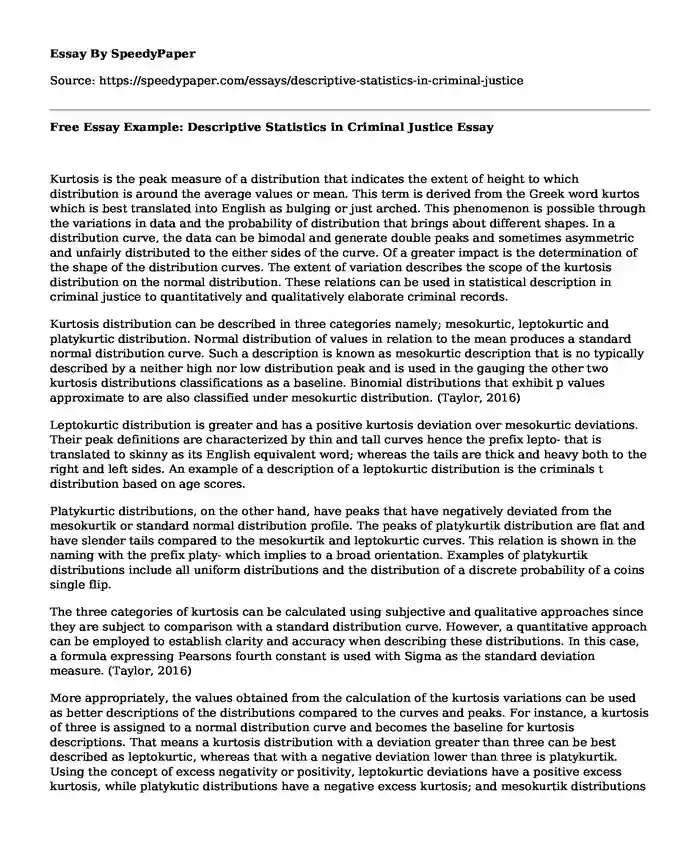
| Type of paper: | Essay |
| Categories: | Statistics Criminal justice |
| Pages: | 3 |
| Wordcount: | 639 words |
Kurtosis is the peak measure of a distribution that indicates the extent of height to which distribution is around the average values or mean. This term is derived from the Greek word kurtos which is best translated into English as bulging or just arched. This phenomenon is possible through the variations in data and the probability of distribution that brings about different shapes. In a distribution curve, the data can be bimodal and generate double peaks and sometimes asymmetric and unfairly distributed to the either sides of the curve. Of a greater impact is the determination of the shape of the distribution curves. The extent of variation describes the scope of the kurtosis distribution on the normal distribution. These relations can be used in statistical description in criminal justice to quantitatively and qualitatively elaborate criminal records.
Kurtosis distribution can be described in three categories namely; mesokurtic, leptokurtic and platykurtic distribution. Normal distribution of values in relation to the mean produces a standard normal distribution curve. Such a description is known as mesokurtic description that is no typically described by a neither high nor low distribution peak and is used in the gauging the other two kurtosis distributions classifications as a baseline. Binomial distributions that exhibit p values approximate to are also classified under mesokurtic distribution. (Taylor, 2016)
Leptokurtic distribution is greater and has a positive kurtosis deviation over mesokurtic deviations. Their peak definitions are characterized by thin and tall curves hence the prefix lepto- that is translated to skinny as its English equivalent word; whereas the tails are thick and heavy both to the right and left sides. An example of a description of a leptokurtic distribution is the criminals t distribution based on age scores.
Platykurtic distributions, on the other hand, have peaks that have negatively deviated from the mesokurtik or standard normal distribution profile. The peaks of platykurtik distribution are flat and have slender tails compared to the mesokurtik and leptokurtic curves. This relation is shown in the naming with the prefix platy- which implies to a broad orientation. Examples of platykurtik distributions include all uniform distributions and the distribution of a discrete probability of a coins single flip.
The three categories of kurtosis can be calculated using subjective and qualitative approaches since they are subject to comparison with a standard distribution curve. However, a quantitative approach can be employed to establish clarity and accuracy when describing these distributions. In this case, a formula expressing Pearsons fourth constant is used with Sigma as the standard deviation measure. (Taylor, 2016)
More appropriately, the values obtained from the calculation of the kurtosis variations can be used as better descriptions of the distributions compared to the curves and peaks. For instance, a kurtosis of three is assigned to a normal distribution curve and becomes the baseline for kurtosis descriptions. That means a kurtosis distribution with a deviation greater than three can be best described as leptokurtic, whereas that with a negative deviation lower than three is platykurtik. Using the concept of excess negativity or positivity, leptokurtic deviations have a positive excess kurtosis, while platykutic distributions have a negative excess kurtosis; and mesokurtik distributions have an excess kurtosis of zero.
The kurtosis distributions can be used in criminal justice descriptive statistics to describe criminals by various variables, say race, security level and the intervals of disciplinary infractions for nominal, ordinal and interval-ratio variables respectively. (Soderstrom & Belvins, 2008) This would make up a better way of criminal data management and analysis within a judicial system.
References
Soderstrom, I. & Belvins, K. (2008). Introductory Criminal Justice Statistics and Data Analysis: Second Edition (2nd ed., pp. 52-54). Long Grove, Illinois: Waveland Press.
Taylor, C. (2016). What Is Kurtosis in Statistics?. About.com Education. Retrieved 24 October 2016, from http://statistics.about.com/od/Descriptive-Statistics/a/What-Is-Kurtosis.htmFrisch, R. (1934). Robert Schmidt's Definition of Skewness and Kurtosis. Econometrica, 2(2), 221. http://dx.doi.org/10.2307/1906904
Cite this page
Free Essay Example: Descriptive Statistics in Criminal Justice. (2019, Nov 28). Retrieved from https://speedypaper.com/essays/descriptive-statistics-in-criminal-justice
Request Removal
If you are the original author of this essay and no longer wish to have it published on the SpeedyPaper website, please click below to request its removal:
- Free Essay on Emancipation Story by Larry Lopez
- Essay Sample on Special Duties Citizens Have to Their Country
- Economics Essay Example: Purchasing Power Parity
- Free Essay: Usefulness of Social media in Communication and Decision Making for Marks & Spencer
- Essay Sample on Coach and Player Relationship
- Free Essay: Assessment in the Nursing Process
- Free Essay Sample: What's a Business For?
Popular categories




